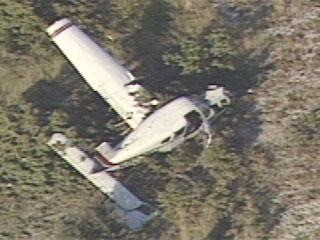This week's accident falls into the category of Job Well Done, Young Pilot!
Here's a pilot who had just received his private ticket a couple of months before executing a near-perfect emergency landing in a parking lot. And he did so with only "minor" injuries to himself and his two passengers. Kinda surprising, given what the wreckage looked like:NTSB Identification: IAD05LA133
14 CFR Part 91: General Aviation
Accident occurred Tuesday, September 06, 2005 in Babylon, NY
Aircraft: Piper PA-28-161, registration: N8270M
Injuries: 3 Minor.
This is preliminary information, subject to change, and may contain errors. Any errors in this report will be corrected when the final report has been completed. On September 6, 2005, at 1725 eastern daylight time, a Piper PA-28-161, N8270M, was substantially damaged when it overran a parking lot during a forced landing to Robert Moses State Park, Babylon, New York. The certificated private pilot and two passengers sustained minor injuries. Visual meteorological conditions prevailed for the local personal flight that departed Republic Airport (FRG), Farmingdale, New York, at 1711. A visual flight rules flight plan was filed for the flight conducted under 14 CFR Part 91.
The pilot provided a written statement, and was interviewed by telephone. He said that it was a "gorgeous, perfect day," and that he intended to fly along the Long Island coastline. The pilot completed the preflight, taxi, and before takeoff checks according to the checklist. He then departed Farmingdale, and climbed the airplane to 2,000 feet with no anomalies noted.
After leveling the airplane at 2,000 feet, the pilot encountered "a lot of roughness in the engine." The engine rpm fluctuated greatly, and the entire airframe vibrated. The pilot declared an emergency via radio to air traffic control at Republic Airport, and stated that he planned to return there.
The engine power continued to decrease, the airplane could not maintain altitude, and the windscreen became obscured by engine oil. The engine oil pressure gauge showed no pressure, and the oil temperature gauge was "as high as it could go." The pilot amended his plan, and elected to land in a parking lot at the Robert Moses Park.
The pilot selected a parking lot for landing due to the relative scarcity of cars parked there. One vehicle was positioned in the center of the lot. The pilot circled the lot in the descent to keep the landing area in sight, as the windscreen was obscured, and selected a ground reference point to ensure that he cleared the vehicle in the center of the lot during landing.
During the landing, the airplane cleared the vehicle, touched down, overran the lot, and collided with two rows of bushes before it came to rest against a sand dune. The right wing separated from the airplane during the accident sequence.
An FAA aviation safety inspector responded to the scene on the day of the accident, and the airplane was then moved to Republic Airport.
The pilot was issued a private pilot certificate with a rating for airplane single engine land on June 1, 2005. He was issued a first class medical certificate in September 2004.
The pilot reported 60 hours of total flight experience, 55 hours of which were in make and model.
The airplane was examined at Republic Airport on September 8, 2005. Examination of the airplane revealed holes in the engine case in the area of the #1 exhaust tappet and the #3 exhaust tappet.
An examination of the airplane's maintenance records revealed that the airplane's engine had accrued 7,069 total hours of flight time, and had accrued 2,771 total hours since major overhaul.
At 2153, the weather reported at Republic Airport included clear skies with 10 miles visibility. The winds were from 130 degrees at 10 knots. The temperature was 68 degrees Fahrenheit, and the dew point was 57 degrees Fahrenheit.

(picture from www.wnbc.com)
My only question is why this particular engine had 2771 hours SMOH. It's used in rental (the aircraft is registered to Nassau Flyers, Inc.). My understanding is that TBO is obligatory, not just advisory, when the aircraft is used for commercial instruction purposes. So, why/how someone let this engine go 700+ hours past TBO is going to be an obvious question that somebody better be prepared to answer.
2 comments:
TBO is obligatory when the aircraft is used for Part 121 or 135 service. When used under part 91, TBO is merely advisory.
I flew airplanes as a CFI that I later learned had 5000+ hours on the engines (they just kept topping em).
I believe that if the plane is used for commercial purposes or leased, the operator can go up to 10% past TBO if the mechanic agrees that the engine is performing properly. Most mechanics will not return an engine to service if it is high time and acting up because of the liability issues. Perhaps on the engine in question they did a top rebuild only?
In any event, there is a limit to the number of times an engine crankcase/crankshaft and pistons can be rebuilt or overhauled. Note the terms rebuilt and overhauled are distinct. Rebuild means some new parts and everything to "field" tolerances while "overhauled" means everything to zero-time tolerances.
Post a Comment